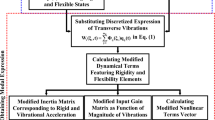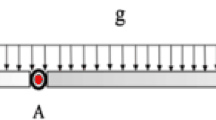Abstract
Previous studies have shown that the absolute coordinate-based formulation is an accurate modeling approach for the rigid-flexible multibody system subject to both large rotation and large deformation. However, it is almost impossible to design the complex controller for a rigid-flexible multibody system via the absolute coordinate-based formulation because of its high dimensions. The primary aim of this study is to design a quasi-optimal controller for a rigid-flexible multibody system via the absolute coordinate-based formulation. The design procedure includes two steps. As the first step, the simplified model for a rigid-flexible multibody system is established via the floating frame of reference formulation first, and then, a time-optimal controller is designed for the simplified model by using the Gauss pseudo-spectral method. In the second step, a quasi-time-optimal closed-loop tracking controller is achieved for the absolute coordinate-based formulation of the rigid-flexible multibody system by superposing a PD controller to track the pre-designed optimal trajectory. The paper presents two case studies for a hub-beam system, where only the motion of the rigid part is observable and driven. The numerical results of the two case studies well verify the effectiveness of the proposed controller.














Similar content being viewed by others
Abbreviations
- \({{\varvec{e}}}\) :
-
Vector of element nodal coordinates
- EA:
-
Tensile stiffness of beam
- EI:
-
Bending stiffness of beam
- G :
-
End-point constraints
- h :
-
General state-control path constraints
- J :
-
Bolza cost function
- \({{\varvec{K}}}_d \) :
-
Proportional gain matrix
- \({{\varvec{K}}}_F \) :
-
Stiffness matrix in FFR formulation
- \({{\varvec{K}}}_p \) :
-
Differential gain matrix
- \({{\varvec{M}}}^{e}\) :
-
Mass matrix of an element
- \({{\varvec{M}}}_A \) :
-
Mass matrix of rigid-flexible multibody system
- \({{\varvec{M}}}_f \) :
-
Mass matrix of flexible part
- \({{\varvec{M}}}_r \) :
-
Mass matrix of rigid part
- \({{\varvec{M}}}_F \) :
-
Mass matrix in FFR formulation
- \(p_i \) :
-
ith modal coordinate of cantilever beam
- \({{\varvec{Q}}}_{Ae}\) :
-
External force vector applied on rigid-flexible multibody system
- \({{\varvec{Q}}}_{Ak}\) :
-
Elastic force vector applied on rigid-flexible multibody system
- \({{\varvec{Q}}}_{Ff} \) :
-
Generalized external force vector in FFR formulation
- \({{\varvec{Q}}}_{Fv} \) :
-
Summation of the centrifugal force vector and the Coriolis force vector in FFR formulation
- \({{\varvec{Q}}}_r \) :
-
Generalized force vector applied on rigid part
- \({{\varvec{Q}}}_e^e \) :
-
External force vector applied on an element
- \({{\varvec{Q}}}_k^e \) :
-
Elastic force vector applied on an element
- \({{\varvec{Q}}}_e^f \) :
-
External force vector applied on flexible part
- \({{\varvec{Q}}}_k^f \) :
-
Elastic force vector applied on flexible part
- \({{\varvec{q}}}_A \) :
-
Generalized coordinate vector of rigid-flexible multibody system
- \({{\varvec{q}}}_F \) :
-
Generalized coordinate vector in FFR formulation
- \({{\varvec{q}}}_f \) :
-
Generalized coordinate vector of flexible part
- \({{\varvec{q}}}_r \) :
-
Generalized coordinate vector of rigid part
- r :
-
Displacement field of an element
- S :
-
Shape function matrix
- T :
-
Kinetic energy of an element
- \(T_0 \) :
-
Moment applied on the hub
- \(t_f \) :
-
Final moment
- U :
-
Strain energy
- u :
-
Control variable vector
- \({{\varvec{u}}}_F \) :
-
Nonzero terms in \({{\varvec{Q}}}_{Ff} \)
- \({{\varvec{u}}}_{F\mathrm{ref}} \) :
-
Designed optimal controller
- \({{\varvec{u}}}_\mathrm{PD} \) :
-
PD controller used to track the designed optimal trajectory
- \({{\varvec{u}}}^{L}\) :
-
Vector of minima of control variable
- \({{\varvec{u}}}^{U}\) :
-
Vector of maxima of control variable
- x :
-
State variable vector
- \({{\varvec{x}}}_A \) :
-
State vector in ACB formulation
- \({{\varvec{x}}}_{A1} \) :
-
Observable state vector in ACB formulation
- \({{\varvec{x}}}_{A2} \) :
-
Unobservable state vector in ACB formulation
- \({{\varvec{x}}}_F \) :
-
State vector in FFR formulation
- \({{\varvec{x}}}_{F1} \) :
-
Observable state vector in FFR formulation
- \({{\varvec{x}}}_{F2} \) :
-
Unobservable state vector in FFR formulation
- \({{\varvec{x}}}_{F\mathrm{ref}} \) :
-
Designed optimal trajectory
- \(\varepsilon _1 \) :
-
A very small value
- \(\rho \) :
-
Density of flexible part
- \(\theta \) :
-
Attitude angle of hub
- \(\dot{\theta }\) :
-
Rotation speed of hub
- \({\varvec{\Phi }}_f ({{\varvec{q}}}_f )\) :
-
Constraint equations of flexible part
- \({\varvec{\Phi }}_r ({{\varvec{q}}}_r )\) :
-
Constraint equations of rigid part
- \({\varvec{\Phi }}_{r-f} ({{\varvec{q}}}_r ,{{\varvec{q}}}_f )\) :
-
Constraint equations between rigid part and flexible part
- \({\varvec{\Phi }}_A \) :
-
Constraint equations of rigid-flexible multibody system
- ACB:
-
Absolute coordinate-based
- ACF:
-
Absolute coordinate formulation
- AMM:
-
Assumed mode method
- ANCF:
-
Absolute nodal coordinate formulation
- FEM:
-
Finite element method
- FFR:
-
Floating frame of reference
- LGR:
-
Legendre-Gauss-Radau
- OOC-FFR:
-
Open-loop optimal controller based on FFR formulation
- PD:
-
Proportional derivative
- PID:
-
Proportional integral derivative
References
Ayoubi, M., Sendi, C.: Takagi–Sugeno fuzzy model-based control of spacecraft with flexible appendage. J. Astronaut. Sci. 61, 40–59 (2015)
Chen, T., Wen, H., Hu, H., Jin, D.: Output consensus and collision avoidance of a team of flexible spacecraft for on-orbit autonomous assembly. Acta Astronaut. 121, 271–281 (2016)
Di Gennaro, S.: Output stabilization of flexible spacecraft with active vibration suppression. IEEE Trans. Aerosp. Electon. Syst. 39, 747–759 (2003)
Cai, G.P., Hong, J., Yang, S.X.: Dynamic analysis of a flexible hub-beam system with tip mass. Mech. Res. Commun. 32, 173–190 (2005)
Hu, Q.: Robust adaptive sliding mode attitude maneuvering and vibration damping of three-axis-stabilized flexible spacecraft with actuator saturation limits. Nonlinear Dyn. 55, 301–321 (2009)
Azadi, M., Fazelzadeh, S.A., Eghtesad, M., Azadi, E.: Vibration suppression and adaptive-robust control of a smart flexible satellite with three axes maneuvering. Acta Astronaut. 69, 307–322 (2011)
Du, H., Li, S.: Attitude synchronization control for a group of flexible spacecraft. Automatica 50, 646–651 (2014)
Xiao, Y., Ye, D., Yang, Z., Sun, Z.: Research on attitude adjustment control for large angle maneuver of rigid-flexible coupling spacecraft. In: The 8th International Conference on Intelligent Robotics and Applications (ICIRA2015), pp. 24–33 (2015)
Liu, C., Tian, Q., Hu, H.: Dynamics and control of a spatial rigid-flexible multibody system with multiple cylindrical clearance joints. Mech. Mach. Theory 52, 106–129 (2012)
de Jalón, J.: Twenty-five years of natural coordinates. Multibody Syst. Dyn. 18, 15–33 (2007)
Escalona, J.L., Hussien, H.A., Shabana, A.A.: Application of the absolute nodal co-ordinate formulation to multibody system dynamics. J. Sound Vib. 214, 833–851 (1998)
Hyldahl, P., Mikkola, A., Balling, O., Sopanen, J.: Behavior of thin rectangular ANCF shell elements in various mesh configurations. Nonlinear Dyn. 78, 1277–1291 (2014)
Mikkola, A.M., Matikainen, M.K.: Development of elastic forces for a large deformation plate element based on the absolute nodal coordinate formulation. J. Comput. Nonlinear Dyn. 1, 103–108 (2005)
Sun, J., Tian, Q., Hu, H.: Structural optimization of flexible components in a flexible multibody system modeled via ANCF. Mech. Mach. Theory 104, 59–80 (2016)
Wang, Z., Tian, Q., Hu, H.: Dynamics of spatial rigid-flexible multibody systems with uncertain interval parameters. Nonlinear Dyn. 84, 527–548 (2016)
Tian, Q., Xiao, Q., Sun, Y., Hu, H., Liu, H., Flores, P.: Coupling dynamics of a geared multibody system supported by elastohydrodynamic lubricated cylindrical joints. Multibody Syst. Dyn. 33, 259–284 (2015)
Chang, H., Liu, C., Tian, Q., Hu, H., Mikkola, A.: Three new triangular shell elements of ANCF represented by bézier triangles. Multibody Syst. Dyn. 35, 321–351 (2015)
Gerstmayr, J., Sugiyama, H., Mikkola, A.: Review on the absolute nodal coordinate formulation for large deformation analysis of multibody systems. J. Comput. Nonlinear Dyn. 8, 1–12 (2013)
García-Vallejo, D., Escalona, J.L., Mayo, J., Domínguez, J.: Describing rigid-flexible multibody systems using absolute coordinates. Nonlinear Dyn. 34, 75–94 (2003)
Tian, Q., Liu, C., Machado, M., Flores, P.: A new model for dry and lubricated cylindrical joints with clearance in spatial flexible multibody systems. Nonlinear Dyn. 64, 25–47 (2011)
García-Vallejo, D., Mayo, J., Escalona, J.L., Domínguez, J.: Three-dimensional formulation of rigid-flexible multibody systems with flexible beam elements. Multibody Syst. Dyn. 20, 1–28 (2008)
Tian, Q., Zhang, Y., Chen, L., Yang, J.: Two-link flexible manipulator modelling and tip trajectory tracking based on the absolute nodal coordinate method. Int. J. Robot. Autom. 24, 103–110 (2009)
García-Vallejo, D., Mayo, J., Escalona, J.L., Domínguez, J.: Efficient evaluation of the elastic forces and the Jacobian in the absolute nodal coordinate formulation. Nonlinear Dyn. 35, 313–329 (2004)
Garcia-Vallejo, D., Mayo, J., Escalona, J.L., Dominguez, J.: Three-dimensional formulation of rigid-flexible multibody systems with flexible beam elements. Multibody Syst. Dyn. 20, 1–28 (2008)
Pan, K., Liu, J.: Investigation on the choice of boundary conditions and shape functions for flexible multi-body system. Acta Mech. Sin. 28, 180–189 (2012)
Yoo, H.H., Lee, S.H., Shin, S.H.: Flapwise bending vibration analysis of rotating multi-layered composite beams. J. Sound Vib. 286, 745–761 (2005)
Wasfy, T.M., Noor, A.K.: Computational strategies for flexible multibody systems. Appl. Mech. Rev. 56, 553–614 (2003)
Yang, J.B., Jiang, L.J., Chen, D.: Dynamic modelling and control of a rotating Euler–Bernoulli beam. J. Sound Vib. 274, 863–875 (2004)
Kane, T.R., Ryan, R., Banerjee, A.K.: Dynamics of a cantilever beam attached to a moving base. J. Guid. Control Dyn. 10, 139–151 (1987)
Wen, H., Jin, D.P., Hu, H.Y.: Optimal feedback control of the deployment of a tethered subsatellite subject to perturbations. Nonlinear Dyn. 51, 501–514 (2008)
Betts, J.T.: Survey of numerical methods for trajectory optimization. J. Guid. Control Dyn. 21, 193–207 (1998)
Ross, I.M., Fahroo, F.: Pseudospectral knotting methods for solving nonsmooth optimal control problems. J. Guid. Control Dyn. 27, 397–405 (2004)
Rao, A.V., Benson, D.A., Darby, C., Patterson, M.A., Francolin, C., Sanders, I., Huntington, G.T.: Algorithm 902: GPOPS, a matlab software for solving multiple-phase optimal control problems using the gauss pseudospectral method. ACM Trans. Math. Softw. 37, 1–39 (2010)
Garg, D., Patterson, M.A., Francolin, C., Darby, C.L., Huntington, G.T., Hager, W.W., Rao, A.V.: Direct trajectory optimization and costate estimation of general optimal control problems using a radau pseudospectral method. Comput. Optim. Appl. 49, 335–358 (2011)
Garg, D., Patterson, M., Hager, W.W., Rao, A.V., Benson, D.A., Huntington, G.T.: A unified framework for the numerical solution of optimal control problems using pseudospectral methods. Automatica 46, 1843–1851 (2010)
Garg, D., Hager, W.W., Rao, A.V.: Pseudospectral methods for solving infinite-horizon optimal control problems. Automatica 47, 829–837 (2011)
Guy, N., Alazard, D., Cumer, C., Charbonnel, C.: Dynamic modeling and analysis of spacecraft with variable tilt of flexible appendages. J. Dyn. Syst. Trans ASME 136, 210201–2102010 (2014)
Liu, J., Lu, H.: Rigid-flexible coupling dynamics of three-dimensional hub-beams system. Multibody Syst. Dyn. 18, 487–510 (2007)
Berzeri, M., Shabana, A.A.: Development of simple models for the elastic forces in the absolute nodal co-ordinate formulation. J. Sound Vib. 235, 539–565 (2000)
Acknowledgements
This work was supported in part by the National Natural Science Foundation of China under Grants 11290153, 11402111 and 11372130, and in part by Foundation for the Author of National Excellent Doctoral Dissertation of China under Grant 201233.
Author information
Authors and Affiliations
Corresponding author
Rights and permissions
About this article
Cite this article
Chen, T., Wen, H., Hu, H. et al. Quasi-time-optimal controller design for a rigid-flexible multibody system via absolute coordinate-based formulation. Nonlinear Dyn 88, 623–633 (2017). https://doi.org/10.1007/s11071-016-3265-4
Received:
Accepted:
Published:
Issue Date:
DOI: https://doi.org/10.1007/s11071-016-3265-4




